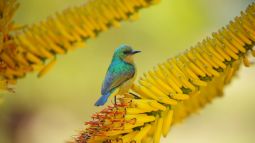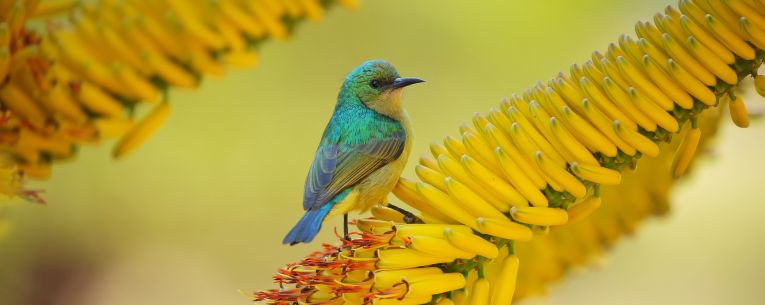A passion for birdwatching can start in your backyard, then take you around the globe. All you need is a passport, an identification guide, and a good pair of binoculars.
What defines a great birding destination? That depends on what you’re looking for.
- Diversity: Some places, notably rainforest habitats and migration stopovers, promise an abundance of different birds.
- Endemic species: Endemic birds are those found in a particular area and nowhere else.
- Rarity: Maybe your birding dream is seeing the New Caledonian Owlet-nightjar, a secretive species that hasn’t been spotted since 1998.
- Specialty: You may travel to see just one particular kind of bird, such as the puffins that nest in huge numbers on Iceland’s Vestmannaeyjar Islands or the pink flamingoes of Kenya’s Lake Nakuru.
- Natural beauty and ecology: Most of the best birding spots also offer opportunities for hiking, wildlife-watching, and simply appreciating your surroundings.
Wherever you go, be sure to learn and follow birding ethics. Never harass birds by getting too close, trying to touch them, playing recorded bird calls, or otherwise intruding on their lives. If you spot a rare species that’s threatened by poaching, don’t reveal its location.
In addition to protecting the birds, protect yourself with travel insurance. For international travel to remote and wild locations, you need a plan with robust emergency medical and emergency transportation benefits, such as OneTrip Prime or OneTrip Premier. Avid travelers love AllTrips Premier, which can cover all your adventures for 365 days. Get a quote!
Cape May, New Jersey
Best times for birding: May-June, September-October
Geography is the reason Cape May is the #1 birding destination in the U.S. This beach town sits on the tip of a peninsula that juts into the Atlantic Ocean, making it a natural rest stop for migrating birds. In the spring and fall, you can see a variety of birds of prey, such as osprey, peregrine falcons, and hawks; shorebirds, seabirds; and also colorful warblers, wrens, swallows and buntings.1 In May and early June, more than a million birds may visit the shore to feast on the eggs of the horseshoe crab. Sometimes, adverse weather conditions result in a fallout: a phenomenon when thousands of exhausted birds alight at the same time seeking food and rest.
While seasonal migrations are the most popular times to go birding in Cape May, there are also 146 nesting species, including brilliant scarlet tanagers in the forests and yellow prothonotary warblers in the swamps.2 When you need a break, stroll around Cape May and enjoy the historic lighthouse, elaborate Victorian architecture, and quirky boutiques.
Kruger National Park, South Africa
Best time for birding: October-March
You’ll be amazed by the abundance of beautiful birds in this savannah habitat. Common sightings include the brilliantly colored lilac-breasted roller; comical-looking hornbills, the iridescent blue-black Burchell’s starling; and the chatty gray go-away-bird. There are several species of vulture, hawk and eagle. If you’re lucky, you may even spot the secretarybird: a tall, white-and-black raptor that strides through the grass looking for small prey.
If you want to see the big beasts Kruger is famous for—such as lions, leopards, rhinos and elephants—you should visit in the dry season, from May to October. That’s when vegetation is sparse and animals gather at watering holes. The best birding season in Kruger, however, is October to March. When the summer rains begin, migrating birds arrive in the park and bring the total number of species to around 500. You may get the chance to see flamboyant mating displays, birds nesting and raising their young, and flowers blooming everywhere. This Kruger birding calendar gives you a sense of what to expect.
The Galápagos Islands, Ecuador
Best time for birding: April-June
When Charles Darwin visited the remote Galápagos in the 1830s, he discovered several unknown species of birds that were virtually identical except for the shape of their beak. He later theorized that these birds—which we now call Darwin’s finches—had evolved over time to adapt to different niches on the islands, bolstering his theory of natural selection.3
If you visit the Galápagos today, you can see Darwin’s finches as well as many other fascinating birds. Some of the best known are the blue-footed booby, the red-and-black frigatebirds, the adorable Galápagos penguins, and the flightless cormorants, which are able to dive to great depths in pursuit of fish.
The Galápagos Islands are a top birding destination any time of year. Experts suggest going in April to see the Galápagos albatross arrive; May to see the flamboyant mating displays of the frigatebirds; or June to see the penguins, cormorants and other species nesting.4
Read more in our guide to visiting the Galápagos Islands.
Indonesia
Best time for birding: May-October
An estimated 17% of the world’s bird population lives in Indonesia—more than 1,600 species! However, with 18,000-plus islands in the archipelago, you could spend decades trying to see them all. That’s why a guided tour is the best choice for a birding trip to Indonesia. Destinations might include:
- Flores Island, where you may spot extravagantly named birds like the glittering kingfisher, elegant pitta, and Wallace’s hanging parrot5
- Bali, home to bee-eaters, sunbirds, kingfishers and many more tropical birds. The striking Bali starling or Bali mynah is sometimes seen in West Bali National Park, although only a few dozen are thought to survive in the wild.
- Way Kambas National Park in southern Sumatra, which is best known for elephants but is also a hotspot for owl sightings on nocturnal birding expeditions.
- The West Papuan Islands, where you’ll find some of the rarest and most spectacular birds, including Wilson’s bird-of-paradise, red bird-of-paradise, and others.
Colombia
Best time for birding: January-March, June-September
With more than 1,900 species, Colombia wins the Most Birds crown. You may even see a few you recognize, as some warblers migrate from Colombia to the United States and back each year. One memorable experience is the Northern Colombia Birding Trail, in which local guides—including members of the indigenous Wayuus—lead you through national parks and private reserves.
The Northern Colombia Birding Trail winds through mountains, dry forest, páramo (high plateau), and coastal habitats. In the little-visited Perijá Mountains (Serranía de Perijá) in the eastern Andes, lucky birders may spot the endemic Perijá Metaltail hummingbird. The Santa Marta Mountains are “the planet’s single most important and irreplaceable site for threatened and endemic biodiversity,” according to Audubon. There, you’ll see tanagers, hummingbirds and quetzals. And if you visit Los Flamencos Flora and Fauna Sanctuary at the right time, you’ll witness a huge gathering of American flamingoes.
Ready to fly off on your next birding adventure? Protect yourself with the travel insurance trusted by more than 70 million American travelers.
Related Articles








Share this Page